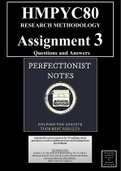Exam (elaborations)
HMPYC80 Research Methodology Assignment 3 Questions and Correct Answers 2022
- Institution
- University Of South Africa (Unisa)
100%. Multiple choice quiz - 33 questions and answers with page numbers and evidence from the textbook. Ch 9 - 19. Table format included. QUIZ: 1. Which of one of the following statements is NOT true about C-studies? C-studies research do NOT ... a) aim to explore or describe without statistica...
[Show more]



